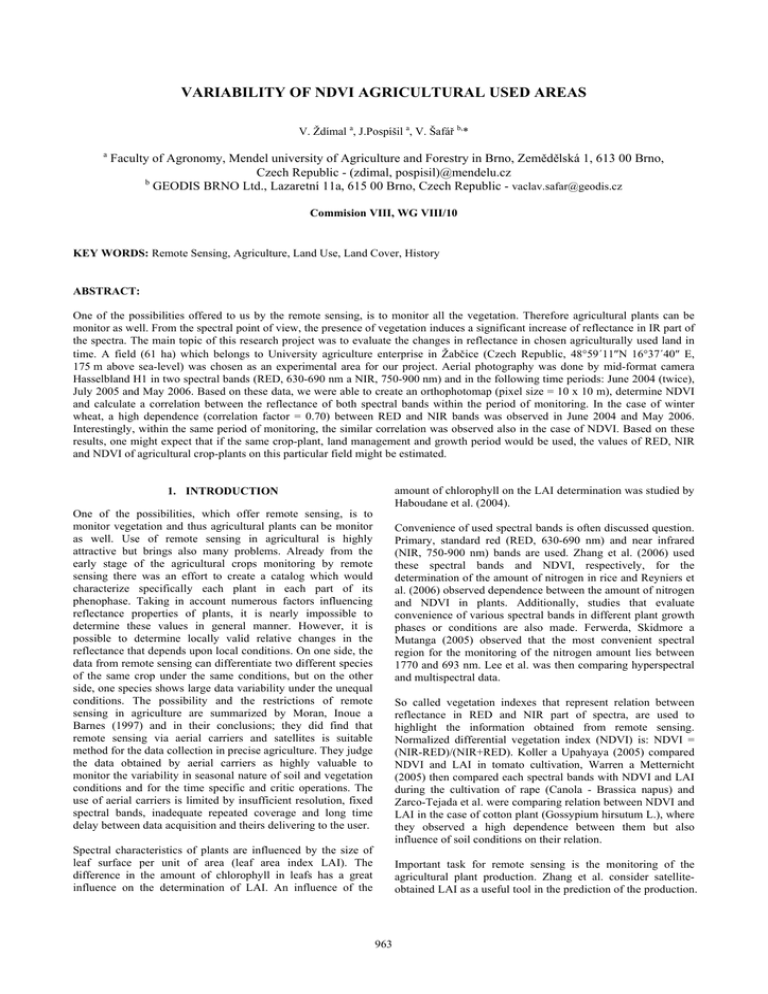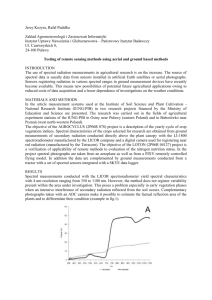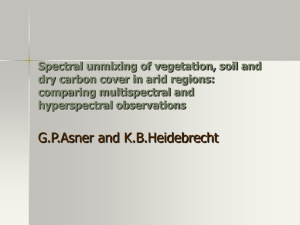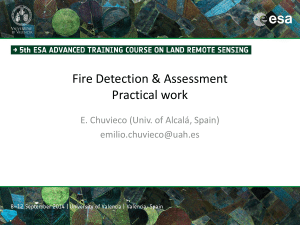VARIABILITY OF NDVI AGRICULTURAL USED AREAS
advertisement

VARIABILITY OF NDVI AGRICULTURAL USED AREAS V. Ždímal a, J.Pospíšil a, V. Šafář b,* a Faculty of Agronomy, Mendel university of Agriculture and Forestry in Brno, Zemědělská 1, 613 00 Brno, Czech Republic - (zdimal, pospisil)@mendelu.cz b GEODIS BRNO Ltd., Lazaretní 11a, 615 00 Brno, Czech Republic - vaclav.safar@geodis.cz Commision VIII, WG VIII/10 KEY WORDS: Remote Sensing, Agriculture, Land Use, Land Cover, History ABSTRACT: One of the possibilities offered to us by the remote sensing, is to monitor all the vegetation. Therefore agricultural plants can be monitor as well. From the spectral point of view, the presence of vegetation induces a significant increase of reflectance in IR part of the spectra. The main topic of this research project was to evaluate the changes in reflectance in chosen agriculturally used land in time. A field (61 ha) which belongs to University agriculture enterprise in Žabčice (Czech Republic, 48°59´11″N 16°37´40″ E, 175 m above sea-level) was chosen as an experimental area for our project. Aerial photography was done by mid-format camera Hasselbland H1 in two spectral bands (RED, 630-690 nm a NIR, 750-900 nm) and in the following time periods: June 2004 (twice), July 2005 and May 2006. Based on these data, we were able to create an orthophotomap (pixel size = 10 x 10 m), determine NDVI and calculate a correlation between the reflectance of both spectral bands within the period of monitoring. In the case of winter wheat, a high dependence (correlation factor = 0.70) between RED and NIR bands was observed in June 2004 and May 2006. Interestingly, within the same period of monitoring, the similar correlation was observed also in the case of NDVI. Based on these results, one might expect that if the same crop-plant, land management and growth period would be used, the values of RED, NIR and NDVI of agricultural crop-plants on this particular field might be estimated. amount of chlorophyll on the LAI determination was studied by Haboudane et al. (2004). 1. INTRODUCTION One of the possibilities, which offer remote sensing, is to monitor vegetation and thus agricultural plants can be monitor as well. Use of remote sensing in agricultural is highly attractive but brings also many problems. Already from the early stage of the agricultural crops monitoring by remote sensing there was an effort to create a catalog which would characterize specifically each plant in each part of its phenophase. Taking in account numerous factors influencing reflectance properties of plants, it is nearly impossible to determine these values in general manner. However, it is possible to determine locally valid relative changes in the reflectance that depends upon local conditions. On one side, the data from remote sensing can differentiate two different species of the same crop under the same conditions, but on the other side, one species shows large data variability under the unequal conditions. The possibility and the restrictions of remote sensing in agriculture are summarized by Moran, Inoue a Barnes (1997) and in their conclusions; they did find that remote sensing via aerial carriers and satellites is suitable method for the data collection in precise agriculture. They judge the data obtained by aerial carriers as highly valuable to monitor the variability in seasonal nature of soil and vegetation conditions and for the time specific and critic operations. The use of aerial carriers is limited by insufficient resolution, fixed spectral bands, inadequate repeated coverage and long time delay between data acquisition and theirs delivering to the user. Convenience of used spectral bands is often discussed question. Primary, standard red (RED, 630-690 nm) and near infrared (NIR, 750-900 nm) bands are used. Zhang et al. (2006) used these spectral bands and NDVI, respectively, for the determination of the amount of nitrogen in rice and Reyniers et al. (2006) observed dependence between the amount of nitrogen and NDVI in plants. Additionally, studies that evaluate convenience of various spectral bands in different plant growth phases or conditions are also made. Ferwerda, Skidmore a Mutanga (2005) observed that the most convenient spectral region for the monitoring of the nitrogen amount lies between 1770 and 693 nm. Lee et al. was then comparing hyperspectral and multispectral data. So called vegetation indexes that represent relation between reflectance in RED and NIR part of spectra, are used to highlight the information obtained from remote sensing. Normalized differential vegetation index (NDVI) is: NDVI = (NIR-RED)/(NIR+RED). Koller a Upahyaya (2005) compared NDVI and LAI in tomato cultivation, Warren a Metternicht (2005) then compared each spectral bands with NDVI and LAI during the cultivation of rape (Canola - Brassica napus) and Zarco-Tejada et al. were comparing relation between NDVI and LAI in the case of cotton plant (Gossypium hirsutum L.), where they observed a high dependence between them but also influence of soil conditions on their relation. Spectral characteristics of plants are influenced by the size of leaf surface per unit of area (leaf area index LAI). The difference in the amount of chlorophyll in leafs has a great influence on the determination of LAI. An influence of the Important task for remote sensing is the monitoring of the agricultural plant production. Zhang et al. consider satelliteobtained LAI as a useful tool in the prediction of the production. 963 The International Archives of the Photogrammetry, Remote Sensing and Spatial Information Sciences. Vol. XXXVII. Part B8. Beijing 2008 possible to determine locally valid relative changes in the reflectance that depends upon variable local conditions. RS data are able to distinguish between two different species of one crop-plant if the same local conditions are used. However, the data collected for the same species might exhibit a large variance if diverse local conditions are used. The conditions that are influencing plant reflectance in the given locality are relatively stable. In general, the main perturbation are caused by the presence of humans, in this case mainly by farming. Figure 1 depicts the monitored locality in years 2004 and 2006. The main question we tried to disclose in our research was to evaluate the changes in reflectance in this chosen agriculturally used land in time. The use of remote sensing for agricultural community was studied by Seelan et al. Based on this research, it was concluded that the following criteria are necessary for the correct use of the remote sensing technology in the agriculture: large number of data users is required, remote sensing does not substitute other information sources, it is necessary to use this method during several campaign, presentation of the method has to be specific for each measured area, information has to be available in close-to-real time and the data has to have a sufficient resolution in space, in time and in used spectral bands. Taking in account numerous factors that are influencing the reflecting properties of plants, it is nearly impossible to determine these values in general manner. However, it is Figure 1. The monitored locality in years 2004 and 2006. similar handling and functionality as an integrated digital camera. The image format is 6 x 4,5 cm (actual size 56 x 41.5 mm). A Phaseone P25 digital back incorporates a 22 megapixel CCD chip with a size of 48.9 x 36.7 mm, 9 x 9 µm pixel pitch, ratio 4:3 ratio and 16 bits per pixel ADC. The images were sensed using custom-made optical filters to obtain two bands (RED and NIR) with spectral properties similar to Landsat TM bands. Each single exposition was directed using GPS according to in advance planed snapshot program using the pinpoint method (according to pre-determined centers of projection). For the precise determination of the corrected center of projection and of tilt-angle against normal line to index display plane, the camera was connected with Aparature POS AV 310 (GPS/INS) from Applanix Ltd. The resulting orthophotomaps of the corresponding spectral bands are prepared by orthogonalization of the aerial digital images to the pre-prepared digital model of the corresponding landscape. The interpretation bases are then obtained by the correct synthesis of the resulting orthophotomaps. The accuracy of position of the orthophotomap corresponds approximately to 2.5 times the size of the ground element. For the standard aerial monitoring, where the size of the ground element is 25 cm, the resulting possible root-mean-square error of position in the orthophotomap generated according to the above given 2. METHODS 2.1 Study site The project was solved on the land of University agriculture enterprise (Mendel University of Agriculture and Forestry in Brno), placed in Žabčice, which is working mainly in the maize area. Field production is focused on the production of cereals and fodder crops and livestock production is focused on beef and pig-rising. Additional activities are focused first of all on the practical aspects of the student education. ŠZP Žabčice controls 1602 ha of the farmland (1353 ha of arable land). The chosen locality has an area of 61 ha (Czech Republic, 48°59´11" N 16°37´40" E, 175 m above sea-level). 2.2 Digital aerial imagery The first step was aerial photo. Based on our experience, and for the reason of data comparison with other research studies in the area, the monitoring was done in two spectral bands (RED, 630-690 nm and NIR, 750-900 nm). Aerial images was done by GEODIS BRNO Ltd. using Z-37A Čmelák airplane equipped with digital medium-format camera Hasselblad H1 with lens of 50.4 mm focal length and Phaseone P25 digital back. Hasselblad H1 is a medium format SLR camera with a number of unique features that support digital backs and provides a 964 The International Archives of the Photogrammetry, Remote Sensing and Spatial Information Sciences. Vol. XXXVII. Part B8. Beijing 2008 reflectance of monitored locality are in Table 1. The normal distribution could be expected for all the parameters and all the parameters have relatively small mean-root-square error. However, the goal of this project was to evaluate how much is changing the reflectance of the chosen agricultural locality in time. For this reason, the correlation between both spectral bands within the monitored period of time was established. The results are presented in Table 2. procedure is approx. 65 cm. Aerial photography was done four times from 1680 m above the landscape: 1. 06/06/2004 - winter wheat in period of flowering (RED060604 a NIR060604) 2. 19/06/2004 - winter wheat in period of wax maturity (RED290604 a NIR290604), 3. 15/07/2005 - maize in period of fast growth (RED150705 a NIR150705), 4. 25/05/2006 - winter wheat in period of flowering (RED250706 a NIR250506). Mean 2.3 Data processing RED060604 NIR060604 RED290604 NIR290604 RED150705 NIR150705 RED250706 NIR250506 Recorded data were compared with measurement standards. Based on these data an orthophotomap (pixel size = 10 x 10 m) was created. Finally, the orthophotomap was transferred into numerical form. The numerical values were then used for the determination of NDVI and other elaboration. 3. RESULTS AND DISCUSSION Four different aerial monitoring were done within the years 2004-2006. All the descriptive statistics of the pixel's (10 x10 m) RED 060604 RED060604 NIR060604 RED290604 NIR290604 RED150705 NIR150705 RED250706 NIR250506 1.00 -0.40 0.78 0.36 0.46 0.13 0.70 -0.08 NIR 060604 RED 290604 -0.40 1.00 -0.59 0.39 -0.01 0.21 -0.19 0.70 0.78 -0.59 1.00 0.07 0.22 0.05 0.47 -0.42 86.07 209.21 66.16 115.19 208.60 168.84 95.05 198.62 57.00 167.00 49.00 94.00 176.00 147.00 69.00 152.00 140.00 228.00 101.00 153.00 236.00 182.00 150.00 227.00 11.58 12.41 6.92 9.02 7.08 5.07 9.19 13.13 Table 1. Descriptive statistics of the reflectance of monitored locality NIR 290604 RED 150705 0.36 0.39 0.07 1.00 0.37 0.33 0.55 0.57 Minimum Maximum Std. Deviation. 0.46 -0.01 0.22 0.37 1.00 0.60 0.57 0.41 NIR 150705 RED 250706 0.13 0.21 0.05 0.33 0.60 1.00 0.30 0.51 0.70 -0.19 0.47 0.55 0.57 0.30 1.00 0.12 NIR 250506 -0.08 0.70 -0.42 0.57 0.41 0.51 0.12 1.00 Table 2. The correlation between both spectral bands within the monitored period during some time periods and to establish the interim values of the reflectance via calculations with some factor of probability. The spectral characteristics of maize in July 2005 were not, according to the observed data, in significant relation with the observed spectral characteristic of winter wheat observed in the years 2004 and 2006. Observed dependence, which are relevant to the goal of our research are: 1. monitoring in spectral band and time RED060604 a RED290604 with correlation 0.78. 2. monitoring in spectral band and time RED060604 a RED250506 with correlation 0.70. 3. monitoring in spectral band and time NIR060604a NIR250506 with correlation 0.70. The values of NDVI were also determined from individual aerial monitoring periods. The correlations between NDVI were significant in the following cases: 1. NDVI060604 and NDVI290604 with correlation 0.64, 2. NDVI060604 and NDVI250706 with correlation 0.74. In the first case, the value of NDVI corresponds to the transition of winter wheat from the period of flowering to wax maturity. We can speak about medium connection. In the second case, where were compared the values of NDVI in the growth period of winter wheat in 2004 and 2006, the correlation was determined to be 0.74. It means that for that for the same species, the same land management and the same growth period in the same locality we can expect with high probability that the distribution of the NDVI values of agricultural species will be similar. In the first case, the slight decrease of reflectance in RED was observed when winter wheat moved from the flowering period into the wax maturity period. Interestingly, the decrease in NIR spectra was even more dramatic. When the data obtained in years 2004 and 2006 were compared, it was evident that the measured data in RED and NIR spectra were correlating (0.70). Therefore we can conclude that for the same species, the same land management and the same growth period in the same locality the distribution of the reflectance's values will be similar. As a consequence it might lead to the proposition to carry out in the future the aerial monitoring only 965 The International Archives of the Photogrammetry, Remote Sensing and Spatial Information Sciences. Vol. XXXVII. Part B8. Beijing 2008 Haboudane, D., Miller, J. R., Patey, E., Zarco-Tejada, P. J. & Strachan, I. B., 2004. Hypespaktral vegetation indices and novel algorihms for predicting green LAI of crop canopies: Modeling and validation in the context of precison agriculture. Remote Sensing of Environment, 90, p. 337 – 352. 4. CONCLUSIONS The use of remote sensing in agriculture is developing especially in the context of technologies of precise farming. The spectral behavior of the vegetation is characterized by significant increase in reflectance in IR. The main goal of this research project was to evaluate the changes in reflectance in the chosen agriculturally used land in time. A field (61 ha) which belongs to ŠZP Žabčice (Czech Republic, 48°59´11" N 16°37´40" E, 175 m above sea-level) was chosen as an experimental area for our project. Aerial photography was done by mid-format camera Hasselbland H1 in two spectral bands (RED, 630-690 nm a NIR, 750-900 nm) and in following time periods: June 2004 (twice), July 2005 and May 2006. Recorded data were compared with measurement standards. Based on these data, an orthophotomap (pixel size = 10 x 10 m) was created. Consequently, NDVI and correlations between reflectance of the measure spectral bands RED and NIR for all the monitored time periods were determined. In the case of winter wheat, a high dependence (0.70) between RED and NIR bands was observed in June 2004 and May 2006. Interestingly, within the same period of monitoring, the similar correlation (0.78) was observed in the case of NDVI. Koller, M. & Upadhyaya, S. K., 2005. Relationship between modified normalized difference vegetation index and leaf area index for processing tomatoes. Applied Engineering in Agriculture, 21 (5), p. 927-933. Moran, M. S., Inoue, Y. & Barnes, E. M., 1997. Opportunities and Limitations for Image-Based Remote Sensing in Precision Crop Management. Remote Sensing of Environment, 61, p. 319346. Zhang, P., Anderson, B., Tan, B., Huang, D. & Myneni, R., 2005. Potential monitoring of crop production using a satellitebased Climate-Variability Impact Index. Agricultural and Forest Meteorology, vol. 132, no. 3-4, p. 344-358. Reyniers, M., Vrindts, E. & DE Baerdemaeker, J., 2006. Comparison of an aerial-based systém and an on the ground continuous measuring device to predict yield of winter wheat. European Journal of Agronomy, vol. 24, no. 2, p. 87-94. Based on these results, one might expect that if the same cropplant, land management and growth period would be used, the values of RED, NIR and NDVI of agricultural crop-plants on this area might be estimated. Warren, G. & Metternicht, G., 2005. Agricultural applications of high-resolution digital multispectral imagery: Evaluating within-field spatial variability of Canola (Brassica napus) in Western Australia. Photogrammetric Engineering and Remote Sensing, 71(5), p. 595-602. Our results suggest that the values of reflectance of agricultural crop-plants in RED and NIR bands and the values of NDVI have relatively permanent character for given agricultural land and species. These results might finally lead to the proposition to carry out in the future the aerial monitoring only during some time periods and to establish the interim values of the reflectance via calculations with some factor of probability. ACKNOWLEDGMENT: This study was supported by the Research plan No. MSM6215648905 “Biological and technological aspects of sustainability of controlled ecosystems and their adaptability to climate change“, which is financed by the Ministry of Education, Youth and Sports of the Czech Republic. REFERENCES Ferwerda, J. G., Skidmore, A. K. & Mutanga, O., 2005. Nitrogen detection with hyperspactral normalized ratio indices across multiple plant species. International Journal of Remote Sensing, 26 (18), p. 4083-4095. 966





